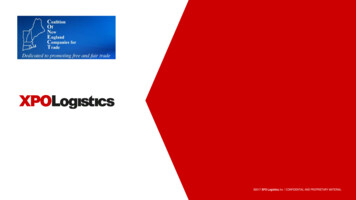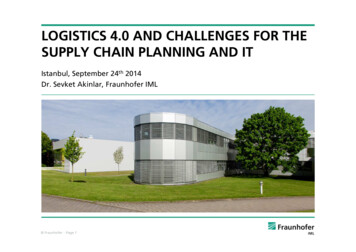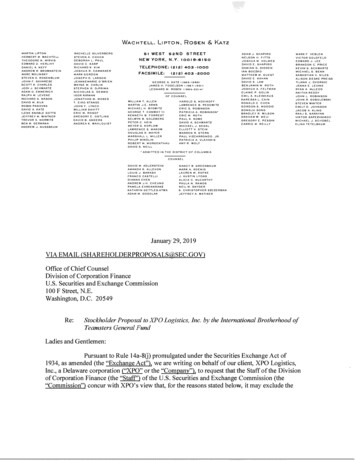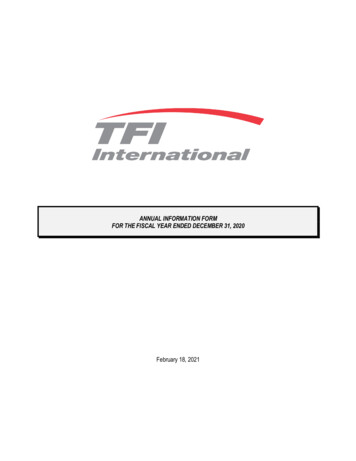
Transcription
2017 XPO Logistics,Inc. CONFIDENTIAL AND PROPRIETARY MATERIAL
OverviewWHY XPOCompanies choose XPO because we have the global scale to manage and transport their goods anywhere in the 00customersPAGE 2
OverviewWHY XPOCustomers rely on XPObecause of ourexperience. Withleadership positionsacross the supply chain,we’ve proven that richdata and industryexpertise give ourcustomers a competitiveadvantage. Largest last mile logistics provider for heavygoods in North America Largest manager of expedited shipments inNorth America Second largest contract logistics providerworldwide based on facility space, with the largestoutsourced e-fulfillment platform in Europe Second largest provider of less-than-truckloadtransportation in North America, and a leading LTLprovider in Western Europe Second largest freight broker worldwide, with aleading road fleet in Europe Third largest provider of intermodal anddrayage services in North America 2018 XPO Logistics, Inc. Confidential and ProprietaryPAGE 3
U.S. Macroeconomicsat a GlanceEconomic Watch: Employment, Manufacturing Remain StrongEmployers continued adding a high number of jobs in March while U.S. factory orders increased broadly in February, but therebound was less than expected, according to two new reports.There were 241,000 private sector jobs additions during the month, according to the latest figures from ADP, the fifth straight monththe level was at 200,000 or better. The February total of jobs added was revised up from 235,000 to 246,000 by the payrollprocessor. There were 241,000 private sector jobsadditions in March, according to thel a t e s t f i g u r e s f r o m A D P, t h e f i f t hstraight month the level was at 200,000o r b e t t e r.Commerce Department Factory Report The latest estimates of the US Q1 GDPreport due from the Bureau of EconomicAnalysis later this month are signalingthat output will rise close to 3%,according to data compiled by TheC a p i t a l S p e c t a t o r.A Commerce Department report showed new orders for U.S. factory-made goods in February increased nearly 1.2%, nearly erasingJanuary’s 1.3% decline. Despite the improvement, it was below a consensus estimate from Wall Street analysts, who expected a1.7% gain. February’s gain was still impressive, rising 7.9%, boosted by a spike in civilian aircraft orders. There were solid gains inorders for electrical equipment, machinery and primary metals.Both new orders and shipments of long-lasting manufactured durable goods also moved higher, as new orders rebounded from adecline in January. Nondurable goods orders declined 0.5% after rising 1% in JanuaryThe Commerce Department revised downward orders for nondefense capital goods excluding aircraft, an indicator of businessinvestment, to show a 1.4% rise, down from a first reported 1.8% improvement. Shipments of these core-capital good increased1.4% in February, the same as reported a month earlier.Source: Trucking Info 2017 XPO Logistics,Inc. CONFIDENTIAL AND PROPRIETARY MATERIALPAGE 4
Tr u c k l o a d I n d u s t r y a t a G l a n c eMore Surcharges, Rejected Freight Sting U.S Truck ShippersMultiple truckload companies are levying surcharges or rejecting freight due to overwhelming demand in the typical slow season.This has trucking officials warning of a sharper crunch when produce season picks up in April and retailers stock up for summer.Trucking companies are busy in the third and fourth quarters when growers sell produce and stores stock up on barbecues, lawncare products and back-to-school items. Demand between those periods typically tapers off, but that is not the case this year.Carriers are struggling to find trucks to satisfy their shippers asking for more service.With new regulations requiring strict adherence to hours of service, drivers are unable to be as productive than on paper logs.Rates have climbed as shippers vie to book highly sought-after appointment windows in these tight schedules.Economic indicators show retailers and manufacturers are thriving from strong demand for products. But trucking companies sayit is difficult to find enough drivers to move products because of the 17-year low unemployment of 4.1% and a drop in dailyproductivity due to ELDs.Source: JOCMorgan Stanley Dry Van Truckload Freight Index The first quarter of 2018 has seen thebest Class 5-7 truck order volume since2006 when the industry was pre-buyingf o r E PA ‘ 0 7 r e g u l a t i o n s . February’s Cass Truckload LinehaulIndex continued the acceleratione s t a b l ish ed i n N o v e m b e r, D e c e m b e r, a n dJ a n u a r y b y p o s t i n g a n o t h e r 6 . 5 % Yo Yi n c r e a s e i n F e b r u a r y.RatesMorgan Stanley National Van Rates After being negative for 13 months in arow (March 2016 - March 2017), theCass TL Linehaul Index has not onlybeen positive now for eleven months,but pricing for trucking continues toincrease. 2017 XPO Logistics,Inc. CONFIDENTIAL AND PROPRIETARY MATERIALPAGE 5
L e s s - T h a n - Tr u c k l o a d I n d u s t r yat a GlanceU.S LTL Trucking Firms Plan Expansions, Higher RatesBasking in what one trucking executive called a “robust, bright” market, LTL carriers are planning expansion in 2018, coupled withcontinuing increases in LTL rates. Several publicly owned LTL carriers will add terminals, trucks, trailers, and employees this year,as industrial and e-commerce freight demand fills more pallets.Contract rates are rising as LTL carriers negotiate annual agreements with shippers. “Rate renewals with contractual customersresulted in an average increase of 6.2% in the fourth quarter,” Rick O’Dell, president and CEO of Saia said.Higher rates will certainly bolster bottom lines at trucking companies with tight profit margins. As freight demand increases, LTLcarriers have stuck to the “pricing discipline” that helped them improve those margins and expand operations or reinvest in theirbusinesses in 2017, adding new equipment and hiring employees. Freight is overflowing, even in the firstq u a r t e r, t r a d i t io na ll y t h e s l o w e s t q u a r t e ro f t h e y e a r. LT L c a r r i e r s a r e a d d i n g t r u c k s , t r a i l e r s ,and employees this year to ensure theycan scale to meet higher freight demandas the economy continues to expand.The LTL expansion has been brewing for more than a year, as trucking companies prepared for a surge in freight. In the second halfof 2017, especially in the fourth quarter, that surge arrived. Operational technology, especially systems that provide visibility toshippers, are likely to be high on carrier priority lists. As the year unfolds, expect LTL carriers to keep a close watch on theintersection of spending, pricing, and profitability.Source: JOCStephens LTL Yield Index Yields have held up on a YOY basis even in the face of strengthening weight per shipment trends. We believe that contractualrate renewals continued to show strength in Q4 as the LTL carriers remained price-disciplined with reported contract renewalsin the range of 4% to 7%. Manufacturing output rose at a 7% ratei n t h e f o u r t h q u a r t e r, t h e l a r g e s t g a i ns i n c e t h e 2 0 1 0 s e c o n d q u a r t e r,according to the US Federal Reserve. 2017 XPO Logistics,Inc. CONFIDENTIAL AND PROPRIETARY MATERIALSource: StephensPAGE 6
Intermodal Industryat a GlanceDomino Effect Grips US Intermodal IndustryNorth American intermodal has gotten off to a rough start this year. January and February usually mark the slowest period of theyear, but business has remained brisk and meeting demand has proved difficult. The intermodal industry is racing to clean up thesituation as more challenges loom.The immediate culprit has been drayage capacity. The dray carrier is emerging as the critical link in an intermodal network. One ofthe unknowns heading into the ELD mandate was the effect on the drayage sector. After two months, it appears the impact has beensignificant, at the upper end of the range of expectation.The biggest issue has been in the long-haul dray segment, which requires ELD-equipped trucks and in which the drivers are mostvulnerable to delays. The results include higher rates, but that is only half the story. The more significant issue is the resulting lack ofdray capacity being felt most acutely in the Midwest. Tight truckload capacity and higherdiesel prices are creating incrementaldemand and pricing power for domesticintermodal.Lack of dray capacity has caused containers to stack up while awaiting highway movement. The passage of container returns to theramp has been impaired, slowing equipment velocity. Chassis supply became tight because too many chassis were trapped awaitingmovement back to the terminal. As inbound rail flow into the terminal continued, the number of grounded boxes mounted, until therewas simply no more room, at which point an embargo of a few days was required to reset the stage and gain some breathing room.In short, it looks as if it is going to be a turbulent year, and the likelihood is that things are going to get worse before they get better.Source: JOCRates As for volumes, Broughton Capitalexplained that domestic containershipment volume may head up at asingle digit pace in 2018, depending ondiesel prices staying at current levels orh i g h e r, a s w e l l a s d e m a n d i n l o n g e rlengths of haul growing at a clip that isable to offset the potential loss ofvolume in shorter lengths of haul. 2017 XPO Logistics,Inc. CONFIDENTIAL AND PROPRIETARY MATERIALPAGE 7
Global Industry at a GlanceAir Freight Demand Growth Starting to Look SustainableAir freight has entered a period of sustainable growth with increasing volume from the e-commerce and pharmaceuticals leading toa decoupling of air cargo demand from goods trade growth and muddying the research waters in the process.The IATA said typically modal shift has eaten into air freight market share during periods of economic stability. Yet even thoughfreight ton km growth has outperformed global goods trade growth in every year since 2014, demand for air freight continues to rise.The expectation is that the outlook for air freight will be supported by a brighter economic and trade backdrop than between 2012and 2017. Having accelerated in 2017, global GDP growth is expected to remain robust over the next five years.Air freight demand has been boosted since mid-2016 by the stronger economic and trade backdrop, bottlenecks in manufacturingsupply chains, and a broader inventory restocking cycle. Although this is good for airline margins, the strong demand has been anightmare for shippers with record high freight rates and severe shortages of space at peak periods. The customary drop in volume after theC h i n e s e N e w Ye a r h o l i d a y s h a d abearing on spot rates for routesoriginating from Asia. As a result,between February and March, Drewry’sEast-West Freight Rate Index plummetedby 17% for a 40ft box.The high cost of air freight is not going to diminish much this year. IATA said the daily utilization rates of large freighter aircrafttrended upward into 2018 and remains at its highest level in more than five years. While this will help to further reduce unit costs forairlines and reinforce cargo airline financial performance, it will keep the squeeze on shippers.Source: JOCGlobal Rates Drewry expects a moderate rate growthf r o m M a y, b u t f o r A p r i l , r a t e s o n k e yEast-West routes are likelyto be soft. Container slot capacity on thetranspacific trades will rise substantiallyin the coming months, with theexpansion set to outpace demandg r o w t h , a c c o r d i n g t o A l p h a l i n e r. 2017 XPO Logistics,Inc. CONFIDENTIAL AND PROPRIETARY MATERIALSource: DrewryPAGE 8
Mexico & Canada Industryat a GlanceCross-Border Truck Freight Value Jumps 10.2%Trucks moved freight valued at 60.6 billion between the U.S, Canada and Mexico in January, up 10.2% compared to January2017, according to newly released Transportation Department figures.The report showed 27.1 billion worth of truck freight moved between the U.S.-Canada border and 33.5 billion worth of cargomoved between the U.S.-Mexico border, increases of 6.2% and 13.6%, respectively when compared to January 2017.In contrast, total U.S. rail moved freight moved between the U.S. and Canada along with Mexico was valued at 13.3 billion, up0.6% during the same period. Movements by pipeline, vessel and air were even less in value.The top states for truck shipments flowing through their ports: Texas with 24.8 billion of truck freight, up 14.3% from 2017 Michigan with 13.3 billion up 5.3% The top commodities being moved crossborder in Q1 were computers and parts,electrical machinery and motor vehicles. The Mexican peso trimmed its losses asN A F TA t a l k s c o n t i n u e , r a l l y i n g f r o m asession low 18.355 per U.S. dollartoward 18.2. Canada’s currency also pared its loss toC 1 . 2 9 1 3 p e r U . S . d o l l a r. New York with 7.4 billion up 3.2%Source: Trucking InfoU.S Pushes NAFTA Talks Pace, Warns of Political HeadwindsMexican and U.S. officials pushed to speed up NAFTA negotiations, with the United States floating the idea of reaching anagreement in coming weeks to avoid political headwinds later this year.U.S. Trade Representative Robert Lighthizer said Mexico’s presidential election and the looming expiry of a congressionalnegotiating authorization in July put the onus on the United States, Mexico and Canada to come up with a plan soon.“We probably have a month, or a month and a half to get an agreement in principle,” Lighthizer told reporters at the conclusion of aseventh round of talks to overhaul the NAFTA in Mexico City.He spoke after meeting the Mexican Economy Minister and the Canadian Foreign Minister for an event marked by a more cordialmood than previous rounds, despite disagreements over President Trump’s plan to impose steel tariffs.Trump has threatened to dump NAFTA unless it boosts U.S. manufacturing and employment, arguing the 1994 accord has causedthe migration of jobs and factories southward to lower-cost Mexico. 2017 XPO Logistics,Inc. CONFIDENTIAL AND PROPRIETARY MATERIALSource: ReutersPAGE 9
Regulatory at a GlanceELD Mandate Law Enforcement Grace Period is OverThe three-month law enforcement grace period for trucks to be equipped with ELDs is over. As of April 1, drivers caught withoutELDs are due to be placed out of service for 10 hours, and may have points added to their Compliance, Safety, Accountabilityprogram scores, or could be fined.There are several specific requirements and suggested practices associated with the ELDs. Some of them include: Drivers and carriers must choose an ELD from a list of self-certified ELDs that are reviewed by FMCSA. The ELD must be capable of transferring data to inspectors during roadside inspections. Drivers may use one of two options,either by telematics such as e-mail or web services, or locally via the use of Universal Serial Bus or Bluetooth. According to CarrierList’s ELD adoptions u r v e y, E L D c o m p l i a n c e r a t e s f o r t h efinal week before the April 1 deadlinespiked to 97%. When an ELD malfunctions, the driver must provide written notice to the carrier within 24 hours and maintain paper logs over thecourse of eight days, the maximum time FMCSA allows for a device to be repaired or replaced. Drivers or carriers can make edits to their ELD record, but drive time cannot be shortened. Drivers should remember to log off the ELD at the end of the day. Officials say one of the biggest problems is drivers not loggingout because it can create complications.Source: Transport Topics Drivers required to operate withan ELD but found to be lacking a devicewill be placed out of service. That OOSorder will be in effect for 10 hours. Atthe end of the OOS period, the driverwill be allowed to continue to their nextscheduled stop using paper logs. Butthe driver should not be dispatchedagain without an ELD.FMCSA Seeks Public Comment on Autonomous Vehicle TechnologyThe organization is requesting public comments on existing Federal Motor Carrier Safety Regulations that may need to be updatedor modified to ease the safe introduction of commercial motor vehicles equipped with automated driving systems, or ADS.FMCSA is requesting comments on regulatory requirements likely to be affected by increased integration of ADS-equipped CMVs.In addition, FMCSA requests information from companies engaged in the design, development, testing, and integration of ADSequipped CMVs into the fleet, about: The scenarios and environments where entities expect that ADS will soon be tested and integrated into CMVs operating on publicroads or in interstate commerce. The operational design domains in which these systems are being operated or would be tested and eventually deployed. Measures they believe are required to ensure the protection of any proprietary or confidential business information they intend toshare with the agency.Public comments on this notice must be received by May 10, 2018, to be included in the FCMSA study. 2017 XPO Logistics,Inc. CONFIDENTIAL AND PROPRIETARY MATERIALSource: Truckinginfo.comPAGE 10
WHY XPO PAGE 2 Companies choose XPO because we have the global scale to manage and transport their goods anywhere in the world. Overview 90,000. employees. 1,435. locations. 31. countries. 50,000. customers 2018 . Cass TL Linehaul Index has not only been positive now for eleven months,










